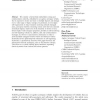Free Online Productivity Tools
i2Speak
i2Symbol
i2OCR
iTex2Img
iWeb2Print
iWeb2Shot
i2Type
iPdf2Split
iPdf2Merge
i2Bopomofo
i2Arabic
i2Style
i2Image
i2PDF
iLatex2Rtf
Sci2ools
ALIFE
2005
2005
Self-Organizing Hierarchies in Sensor and Communication Networks
We consider a hierarchical multicellular sensing and communication network, embedded in an ageless aerospace vehicle, that is expected to detect and react to multiple impacts and damage over a wide range of impact energies. In particular, we investigate self-organization of impact boundaries enclosing critically damaged areas, and impact networks connecting remote cells that have detected noncritical impacts. Each level of the hierarchy is shown to have distinct higher-order emergent properties, desirable in self-monitoring and self-repairing vehicles. In addition, cells and communication messages are shown to need memory (hysteresis) in order to retain desirable emergent behavior within and between various hierarchical levels. Spatiotemporal robustness of self-organizing hierarchies is quantitatively measured with graph-theoretic and information-theoretic techniques, such as the Shannon entropy. This allows us to clearly identify phase transitions separating chaotic dynamics from orde...
Ageless Aerospace Vehicle | ALIFE 2005 | ALIFE 2007 | Desirable Emergent Behavior | Hierarchical Multicellular Sensing |
| Added | 15 Dec 2010 |
| Updated | 15 Dec 2010 |
| Type | Journal |
| Year | 2005 |
| Where | ALIFE |
| Authors | Mikhail Prokopenko, Peter Wang, Philip Valencia, Don Price, Mark Foreman, Anthony Farmer |
Comments (0)

